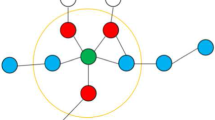Abstract
Several modern network embedding methods learn vector representations from sampled context nodes. The sampling strategies are often carefully designed and controlled by specific parameters that enable them to adapt to different networks. However, the following fundamental question remains: what is the key factor that causes some sampling context results to yield better vectors than others on a certain network? We attempted to answer the question from the perspective of information theory. First, we defined the weighted entropy of the sampled context matrix, which denotes the amount of information it takes. We discovered that context matrices with higher weighted entropy generally produce better vectors. Second, we proposed maximum weighted entropy sampling methods for sampling more informative context nodes; thus, it can be used to produce more informative vectors. Herein, the results of the extensive experiments on the link prediction and node classification tasks confirm the effectiveness of the proposed methods.
Similar content being viewed by others
References
Sen P, Namata G, Bilgic M, et al. Collective classification in network data. AI Mag, 2008, 29: 93
Chandola V, Banerjee A, Kumar V. Anomaly detection: a survey. ACM Comput Surv, 2009, 41: 1–58
Yang J, McAuley J, Leskovec J. Community detection in networks with node attributes. In: Proceedings of the 13th International Conference on Data Minin, 2013. 1151–1156
Liben-Nowell D, Kleinberg J. The link-prediction problem for social networks. J Am Soc Inform Sci Technol, 2007, 58: 1019–1031
Perozzi B, Al-Rfou R, Skiena S. Deepwalk: online learning of social representations. In: Proceedings of the 20th ACM SIGKDD International Conference on Knowledge Discovery and Data Mining, 2014. 701–710
Grover A, Leskovec J. node2vec: scalable feature learning for networks. In: Proceedings of the 22nd ACM SIGKDD International Conference on Knowledge Discovery and Data Mining, 2016. 855–864
Tang J, Qu M, Wang M Z, et al. Line: large-scale information network embedding. In: Proceedings of the 24th International Conference on World Wide Web, 2015. 1067–1077
Wang D X, Cui P, Zhu W W. Structural deep network embedding. In: Proceedings of the 22nd ACM SIGKDD International Conference on Knowledge Discovery and Data Mining, 2016. 1225–1234
Abu-El-Haija S, Perozzi B, Al-Rfou R, et al. Watch your step: learning node embeddings via graph attention. In: Proceedings of the 32nd Conference on Neural Information Processing System, 2018. 9198–9208
Dong Y X, Chawla N V, Swami A. metapath2vec: scalable representation learning for heterogeneous networks. In: Proceedings of the 23rd ACM SIGKDD International Conference on Knowledge Discovery and Data Mining, 2017. 135–144
Zhang D K, Yin J, Zhu X Q, et al. MetaGraph2Vec: complex semantic path augmented heterogeneous network embedding. In: Proceedings of Pacific-Asia Conference on Knowledge Discovery and Data Mining, 2018. 196–208
Liao L Z, He X N, Zhang H W, et al. Attributed social network embedding. IEEE Trans Knowl Data Eng, 2018, 30: 2257–2270
Mikolov T, Chen K, Corrado G, et al. Efficient estimation of word representations in vector space. 2013. ArXiv:1301.3781
Qiu J Z, Dong Y X, Ma H, et al. Network embedding as matrix factorization: unifying deepwalk, line, pte, and node2vec. In: Proceedings of the 11th ACM International Conference on Web Search and Data Mining, 2018. 459–467
Guiaşu S. Weighted entropy. Rep Math Phys, 1971, 2: 165–179
Kingma D P, Ba J. Adam: a method for stochastic optimization. 2014. ArXiv:1412.6980
Tang L, Liu H. Relational learning via latent social dimensions. In: Proceedings of the 15th ACM SIGKDD International Conference on Knowledge Discovery and Data Mining, 2009. 817–826
Cao S S, Lu W, Xu Q K. Grarep: learning graph representations with global structural information. In: Proceedings of the 24th ACM International on Conference on Information and Knowledge Management, 2015. 891–900
Zou K H, O’Malley A J, Mauri L. Receiver-operating characteristic analysis for evaluating diagnostic tests and predictive models. Circulation, 2007, 115: 654–657
Yang M S, Nataliani Y. A feature-reduction fuzzy clustering algorithm based on feature-weighted entropy. IEEE Trans Fuzzy Syst, 2018, 26: 817–835
Park E, Ahn J, Yoo S. Weighted-entropy-based quantization for deep neural networks. In: Proceedings of IEEE Conference on Computer Vision and Pattern Recognition, 2017
Feng X C, Qin B, Liu T. A language-independent neural network for event detection. Sci China Inf Sci, 2018, 61: 092106
Li X L, Zhuang Y, Fu Y J, et al. A trust-aware random walk model for return propensity estimation and consumer anomaly scoring in online shopping. Sci China Inf Sci, 2019, 62: 052101
Perozzi B, Kulkarni V, Skiena S. Walklets: multiscale graph embeddings for interpretable network classification. 2016. ArXiv:1605.02115
Acknowledgements
This work was supported in part by Social Science Foundation of the Jiangsu Higher Education Institutions of China (Grant No. 2018SJA0455), National Nature Science Foundation of China (Grant No. 61472183), and Social Science Foundation of Jiangsu Province (Grant No. 19TQD002).
Author information
Authors and Affiliations
Corresponding author
Rights and permissions
About this article
Cite this article
Zhu, D., Dai, XY., Chen, J. et al. Sampling informative context nodes for network embedding. Sci. China Inf. Sci. 64, 212104 (2021). https://doi.org/10.1007/s11432-019-2635-8
Received:
Revised:
Accepted:
Published:
DOI: https://doi.org/10.1007/s11432-019-2635-8




